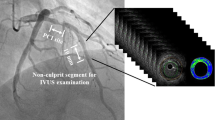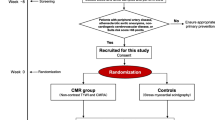Abstract
Purpose
While it is well known that patients with chronic kidney disease (CKD) are at increased risk for the development and progression of atherosclerosis, it is not known whether arterial inflammation is increased in mild CKD. The aim of this study was to compare arterial inflammation using 18F-FDG PET/CT in patients with CKD and in matched controls.
Methods
This restrospective study included 128 patients undergoing FDG PET/CT imaging for clinical indications, comprising 64 patients with stage 3 CKD and 64 control patients matched by age, gender, and cancer history. CKD was defined according to guidelines using a calculated glomerular filtration rate (eGFR). Arterial inflammation was measured in the ascending aorta as FDG uptake on PET. Background FDG uptake (venous, subcutaneous fat and muscle) were recorded. Coronary artery calcification (CAC) was assessed using the CT images. The impact of CKD on arterial inflammation and CAC was then assessed.
Results
Arterial inflammation was higher in patients with CKD than in matched controls (standardized uptake value, SUV: 2.41 ± 0.49 vs. 2.16 ± 0.43; p = 0.002). Arterial SUV correlated inversely with eGFR (r = −0.299, p = 0.001). Venous SUV was also significantly elevated in patients with CKD, while subcutaneous fat and muscle tissue SUVs did not differ between groups. Moreover, arterial SUV remained significantly elevated in patients with CKD compared to controls after correcting for muscle and fat background, and also remained significant after adjusting for clinical risk factors. Further, CKD was associated with arterial inflammation (SUV) independent of the presence of subclinical atherosclerosis (CAC).
Conclusion
Moderate CKD is associated with increased arterial inflammation beyond that of controls. Further, the increased arterial inflammation is independent of presence of subclinical atherosclerosis. Current risk stratification tools may underestimate the presence of atherosclerosis in patients with CKD and thereby the risk of cardiovascular events.




Similar content being viewed by others
References
Hoerger TJ, Simpson SA, Yarnoff BO, Pavkov ME, Rios Burrows N, Saydah SH, et al. The future burden of CKD in the United States: a simulation model for the CDC CKD initiative. Am J Kidney Dis. 2015;65:403–11. doi:10.1053/j.ajkd.2014.09.023.
Go AS, Chertow GM, Fan D, McCulloch CE, Hsu CY. Chronic kidney disease and the risks of death, cardiovascular events, and hospitalization. N Engl J Med. 2004;351:1296–305. doi:10.1056/NEJMoa041031.
Schiffrin EL, Lipman ML, Mann JF. Chronic kidney disease: effects on the cardiovascular system. Circulation. 2007;116:85–97. doi:10.1161/CIRCULATIONAHA.106.678342.
Shlipak MG, Fried LF, Cushman M, Manolio TA, Peterson D, Stehman-Breen C, et al. Cardiovascular mortality risk in chronic kidney disease: comparison of traditional and novel risk factors. JAMA. 2005;293:1737–45. doi:10.1001/jama.293.14.1737.
Kiu Weber CI, Duchateau-Nguyen G, Solier C, Schell-Steven A, Hermosilla R, Nogoceke E, et al. Cardiovascular risk markers associated with arterial calcification in patients with chronic kidney disease stages 3 and 4. Clin Kidney J. 2014;7:167–73. doi:10.1093/ckj/sfu017.
Rennen HJ, Boerman OC, Oyen WJ, Corstens FH. Imaging infection/inflammation in the new millennium. Eur J Nucl Med. 2001;28:241–52.
Tawakol A, Migrino RQ, Bashian GG, Bedri S, Vermylen D, Cury RC, et al. In vivo 18F-fluorodeoxyglucose positron emission tomography imaging provides a noninvasive measure of carotid plaque inflammation in patients. J Am Coll Cardiol. 2006;48:1818–24. doi:10.1016/j.jacc.2006.05.076.
Rudd JH, Warburton EA, Fryer TD, Jones HA, Clark JC, Antoun N, et al. Imaging atherosclerotic plaque inflammation with [18F]-fluorodeoxyglucose positron emission tomography. Circulation. 2002;105:2708–11.
Rudd JH, Myers KS, Bansilal S, Machac J, Pinto CA, Tong C, et al. Atherosclerosis inflammation imaging with 18F-FDG PET: carotid, iliac, and femoral uptake reproducibility, quantification methods, and recommendations. J Nucl Med. 2008;49:871–8. doi:10.2967/jnumed.107.050294.
Figueroa AL, Abdelbaky A, Truong QA, Corsini E, MacNabb MH, Lavender ZR, et al. Measurement of arterial activity on routine FDG PET/CT images improves prediction of risk of future CV events. JACC Cardiovasc Imaging. 2013;6:1250–9. doi:10.1016/j.jcmg.2013.08.006.
Rudd JH, Myers KS, Bansilal S, Machac J, Rafique A, Farkouh M, et al. (18)Fluorodeoxyglucose positron emission tomography imaging of atherosclerotic plaque inflammation is highly reproducible: implications for atherosclerosis therapy trials. J Am Coll Cardiol. 2007;50:892–6. doi:10.1016/j.jacc.2007.05.024.
Tahara N, Kai H, Ishibashi M, Nakaura H, Kaida H, Baba K, et al. Simvastatin attenuates plaque inflammation: evaluation by fluorodeoxyglucose positron emission tomography. J Am Coll Cardiol. 2006;48:1825–31. doi:10.1016/j.jacc.2006.03.069.
Wu YW, Kao HL, Huang CL, Chen MF, Lin LY, Wang YC, et al. The effects of 3-month atorvastatin therapy on arterial inflammation, calcification, abdominal adipose tissue and circulating biomarkers. Eur J Nucl Med Mol Imaging. 2012;39:399–407. doi:10.1007/s00259-011-1994-7.
Rogers IS, Nasir K, Figueroa AL, Cury RC, Hoffmann U, Vermylen DA, et al. Feasibility of FDG imaging of the coronary arteries: comparison between acute coronary syndrome and stable angina. JACC Cardiovasc Imaging. 2010;3:388–97. doi:10.1016/j.jcmg.2010.01.004.
Rominger A, Saam T, Wolpers S, Cyran CC, Schmidt M, Foerster S, et al. 18F-FDG PET/CT identifies patients at risk for future vascular events in an otherwise asymptomatic cohort with neoplastic disease. J Nucl Med. 2009;50:1611–20. doi:10.2967/jnumed.109.065151.
Paulmier B, Duet M, Khayat R, Pierquet-Ghazzar N, Laissy JP, Maunoury C, et al. Arterial wall uptake of fluorodeoxyglucose on PET imaging in stable cancer disease patients indicates higher risk for cardiovascular events. J Nucl Cardiol. 2008;15:209–17. doi:10.1016/j.nuclcard.2007.10.009.
Levey AS, Stevens LA, Schmid CH, Zhang YL, Castro 3rd AF, Feldman HI, et al. A new equation to estimate glomerular filtration rate. Ann Intern Med. 2009;150:604–12.
Tawakol A, Fayad ZA, Mogg R, Alon A, Klimas MT, Dansky H, et al. Intensification of statin therapy results in a rapid reduction in atherosclerotic inflammation: results of a multicenter fluorodeoxyglucose-positron emission tomography/computed tomography feasibility study. J Am Coll Cardiol. 2013;62:909–17. doi:10.1016/j.jacc.2013.04.066.
Blomberg BA, Thomassen A, de Jong PA, Simonsen J, Lam M, Nielsen A, et al. Impact of personal characteristics and technical factors on quantification of sodium 18F-fluoride uptake in human arteries: prospective evaluation of healthy subjects. J Nucl Med. 2015;56:1534–40. doi:10.2967/jnumed.115.159798.
Kirsch J, Buitrago I, Mohammed TL, Gao T, Asher CR, Novaro GM. Detection of coronary calcium during standard chest computed tomography correlates with multi-detector computed tomography coronary artery calcium score. Int J Cardiovasc Imaging. 2012;28:1249–56. doi:10.1007/s10554-011-9928-9.
Einstein AJ, Johnson LL, Bokhari S, Son J, Thompson RC, Bateman TM, et al. Agreement of visual estimation of coronary artery calcium from low-dose CT attenuation correction scans in hybrid PET/CT and SPECT/CT with standard Agatston score. J Am Coll Cardiol. 2010;56:1914–21. doi:10.1016/j.jacc.2010.05.057.
Raggi P, Boulay A, Chasan-Taber S, Amin N, Dillon M, Burke SK, et al. Cardiac calcification in adult hemodialysis patients. A link between end-stage renal disease and cardiovascular disease? J Am Coll Cardiol. 2002;39:695–701.
McCullough PA, Sandberg KR, Dumler F, Yanez JE. Determinants of coronary vascular calcification in patients with chronic kidney disease and end-stage renal disease: a systematic review. J Nephrol. 2004;17:205–15.
Moe SM, Chen NX. Mechanisms of vascular calcification in chronic kidney disease. J Am Soc Nephrol. 2008;19:213–6. doi:10.1681/ASN.2007080854.
Haydar AA, Hujairi NM, Covic AA, Pereira D, Rubens M, Goldsmith DJ. Coronary artery calcification is related to coronary atherosclerosis in chronic renal disease patients: a study comparing EBCT-generated coronary artery calcium scores and coronary angiography. Nephrol Dial Transplant. 2004;19:2307–12. doi:10.1093/ndt/gfh120.
Hoh CK. Clinical use of FDG PET. Nucl Med Biol. 2007;34:737–42. doi:10.1016/j.nucmedbio.2007.07.001.
Gallagher BM, Fowler JS, Gutterson NI, MacGregor RR, Wan CN, Wolf AP. Metabolic trapping as a principle of radiopharmaceutical design: some factors resposible for the biodistribution of [18F] 2-deoxy-2-fluoro-D-glucose. J Nucl Med: Off Publ Soc Nucl Med. 1978;19:1154–61.
Gerich JE, Meyer C, Woerle HJ, Stumvoll M. Renal gluconeogenesis: its importance in human glucose homeostasis. Diabetes Care. 2001;24:382–91.
Laffon E, Cazeau AL, Monet A, de Clermont H, Fernandez P, Marthan R, et al. The effect of renal failure on 18F-FDG uptake: a theoretic assessment. J Nucl Med Technol. 2008;36:200–2. doi:10.2967/jnmt.107.049627.
Author information
Authors and Affiliations
Corresponding author
Ethics declarations
Funding
F. Hoffmann-La Roche Ltd., Switzerland
Conflicts of interest
Jessica Mann, Robert A. Comley and Chek Ing Kiu Weber were employed by, and owned stock F. Hoffmann-La Roche Ltd., Basel, Switzerland, at the time of the study.
All other authors have no relationships relevant to the contents of this article to disclose.
Ethical approval
All procedures performed were in accordance with the ethical standards of the institutional and national research committee and with the principles of the 1964 Declaration of Helsinki and its later amendments or comparable ethical standards.
Infomed consent
For this type of study, formal consent is not required.
Rights and permissions
About this article
Cite this article
Takx, R.A.P., MacNabb, M.H., Emami, H. et al. Increased arterial inflammation in individuals with stage 3 chronic kidney disease. Eur J Nucl Med Mol Imaging 43, 333–339 (2016). https://doi.org/10.1007/s00259-015-3203-6
Received:
Accepted:
Published:
Issue Date:
DOI: https://doi.org/10.1007/s00259-015-3203-6




